Some people go to church, others go to churches. We are blessed in Great Britain in having thousands of churches, with England alone having over 37,000. The artefacts and monuments in these churches relate the history of villages and towns and their inhabitants, from the oldest Norman font to the newest Women’s Institute kneelers. No old church is devoid of interest; described here are some we found particularly fascinating for a variety of reasons.
The Church of St Michel de Rupe (St Michael of the Rock), Brentor
Sitting atop Brent Tor on the western edge of Dartmoor, this is the parish church of the village of Brentor, which lies below the Tor, and is the highest church in England. On a clear day, the views from the church are magnificent, and you can easily spot Bodmin Moor and Plymouth Sound.
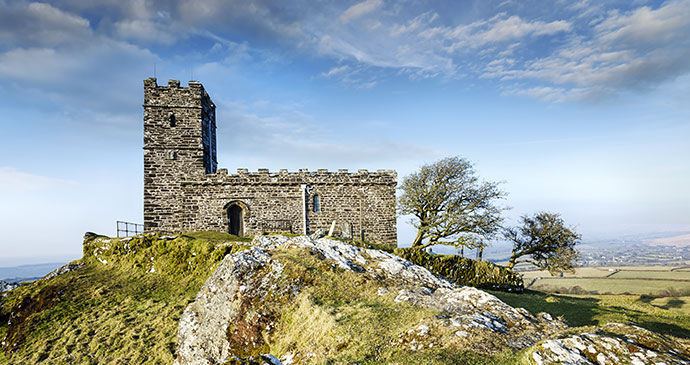
The little church will hold 40 people and services are still held on Christmas Day, Easter Sunday and Sunday evensong is celebrated during the summer months. The building itself is tiny and utterly simple, but the location is superb and is what makes it so special.
St Nonna, Altarnun
Snuggled in a wooded valley, the Cornish village of Altarnun scores top marks for its photogenic qualities. The church of St Nonna, the ‘Cathedral of the Moors’, with its high tower, sits prettily beside a babbling tributary of the Inny, where a 15th-century packbridge leads to part two of the village.
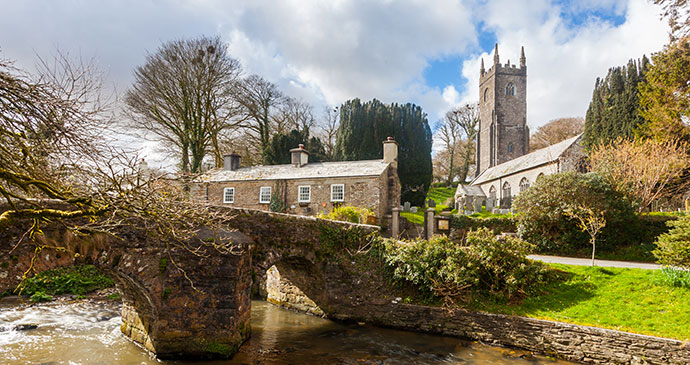
The eighty-odd carved bench ends inside the church are an absolute knockout: there are jesters and jugglers, a piper, fiddler and bagpipe player, a sheaf of corn that is also a face, sheep on the hill and portraits of various characters from the village. They were carved in the early part of the 16th century by one Robert Daye, who proudly added his name to the carvings. You can also visit the holy well, in a field behind the vicarage. Pity the poor ‘lunatics’, who were immersed here backwards before being marched up to the church for complementary prayers.
St Laurence’s, Bradford-on-Avon
In the Cotswolds, Bradford, or ‘Broad Ford’ as it was in Saxon times, has its fair share of agreeable architecture and enticing corners. The tiny but tall Saxon church of St Laurence, the oldest surviving building in town.
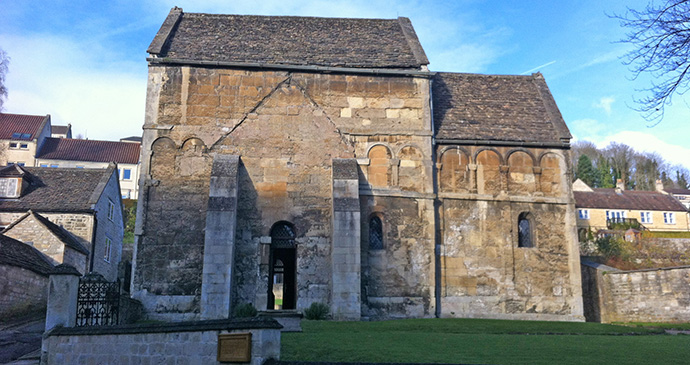
It is still used as a place of worship, though with a dozen people standing inside it’s crowded. Bizarrely the church was once ‘lost’, having been redeveloped into a school and overshadowed by other buildings. It was not until 1856 that a local clergyman came across some old records and discovered the building to be a 10th-century church.
St Catherine’s Chapel, Abbotsbury
Approaching Abbotsbury by road from the west is an absolute delight, as you gaze down towards Chesil Beach, which is watched over by St Catherine’s Chapel. The chapel was built in the 14th century and may have been used as a chantry by the monks. When they built St Catherine’s Chapel they certainly meant it to last – it is constructed entirely of stone, including the roof, with walls four feet thick.
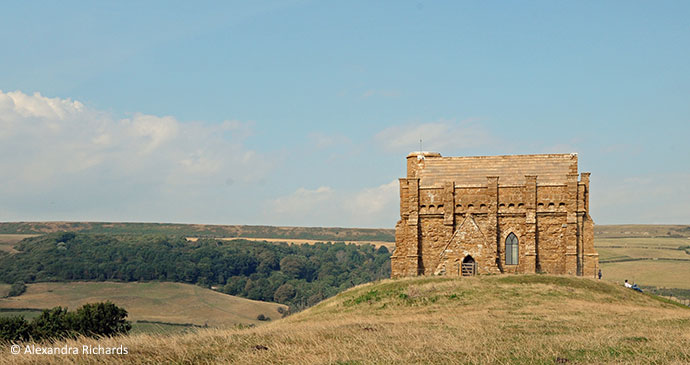
It survived the Dissolution, probably because of its importance as a seamark for shipping. St Catherine is the patron saint of spinsters and for centuries unmarried women have climbed up to the chapel to pray for a husband. I know plenty of girlfriends who have tried everything to find one of those, so a girls’ trip to St Catherine’s Chapel may well be on the cards.
When I last visited, there were several handwritten prayers in the wall of the building asking for husband-hunting help, and the resident white doves seemed to be a good omen. Non-denominational services are held monthly in summer and, should your prayers to St Catherine bear fruit, it is good to know that you can get married here.
The Church of the English Martyrs, Goring
Built-up Goring, in Sussex, has one jaw-dropping surprise. The quite unassuming 1960s hangar-like Church of the English Martyrs in Goring Way a short walk southeast of the railway station reveals nothing until you enter to see a faithful two-thirds size recreation of the Sistine Chapel ceiling painting, created in painstaking detail by professional signwriter and parishioner Gary Bevans from 1987 until 1993, and covering the full 3,500 square feet.

The ceiling is 30 feet lower than Michelangelo’s original, so as well as saving you a trip to the Vatican and an awful lot of queuing, it’s quite a bit easier to see the details in their full (acrylic) glory.
St Magnus Cathedral, Orkney
With a spire that can be seen from out in the Bay of Kirkwall, this cathedral represents the historical and cultural heart of the town. The cathedral was founded in 1137 by Earl Rognvald, nephew of St Magnus, and is dedicated to the eponymous 11th-century earl, who was canonised upon his murder.
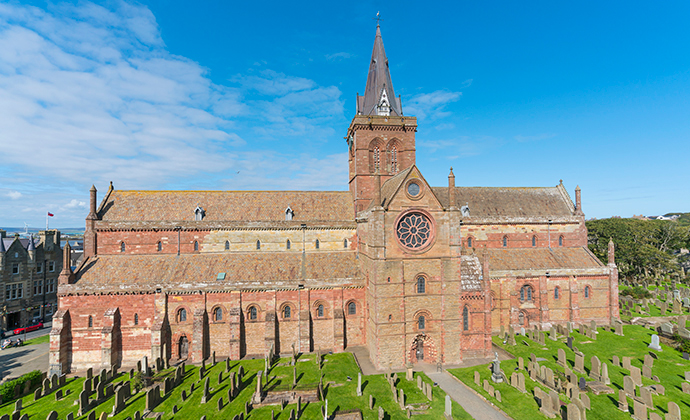
Originally part of the Archdiocese of Nidaros (modern-day Trondheim in Norway), the cathedral was given to the people of Kirkwall by King James III of Scotland after Orkney became part of Scotland in 1468. Today, St Magnus is a parish church of the Presbyterian Church of Scotland, and therefore technically no longer a cathedral.
The cathedral is a striking building made from red and yellow sandstone. The outstanding handiwork is thought partly attributable to the involvement of the stonemasons who built the exquisite cathedral at Durham. The masons left their insignias around the cathedral and volunteers will help you pick out ravens, green men (sculpted faces of deities and sprites), dragons, a squatting female figure known as a Sheela-na-gig and a crow’s foot.
St Oswald’s, Ashbourne
Just down from the almshouses and the original building of Queen Elizabeth’s Grammar School is St Oswald’s Church with ‘the finest spire in England’ – so George Eliot claimed – but definitely the finest in the Peak District.
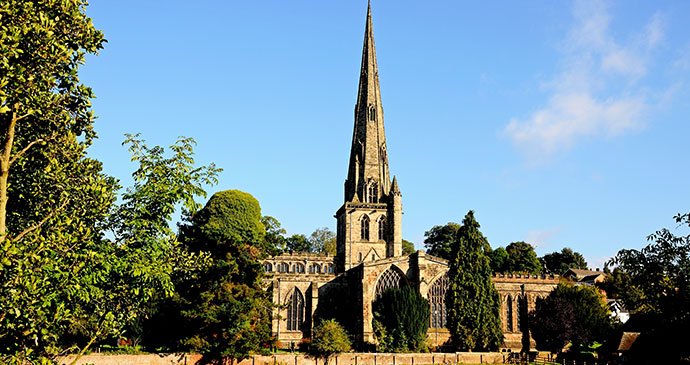
The church makes a statement straight off with its 12 ghoulish skulls supporting the pointed Gothic pillars on the gateposts by the entrance. Inside, the Boothby Chapel is filled with alabaster and marble effigies, chest tombs and wall memorials to the Cokayne, Boothby and Bradbourne families.
The sculpted lords and ladies, resting in majestic repose upon raised tombstones decorated with painted shields, battlements, angels and mythical creatures are impressive, but it’s tiny six-year-old Penelope Boothby in her simple flowing gown who steals the show. The seemingly translucent Carrara marble figure sculpted by Thomas Banks lies on her side, ‘asleep’ in an innocent, childlike slumber: a picture of delicate perfection.
St Helen’s Church, Ranworth
Norfolk’s St Helen’s Church is well worth a visit, not simply because it has some of best screen paintings in the county and a beautifully illuminated antiphoner (service book) on display, but because it has a feature that offers something that geology does not in this neck of the woods – elevation.
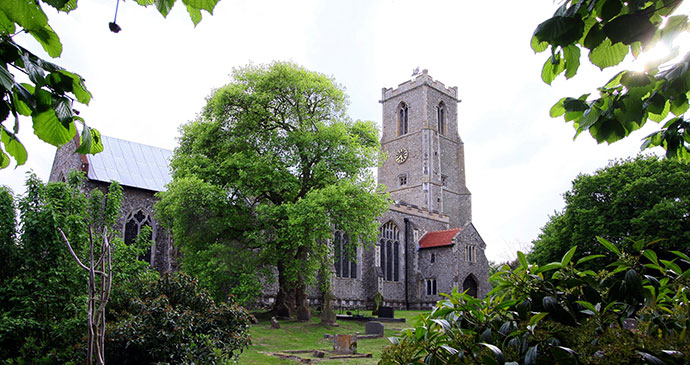
A steep, tightly curving staircase leads up 89 steps to the roof of the church tower. It’s very narrow so try to avoid two-way traffic if at all possible. The view is undoubtedly worth the climb: the broad and river are laid out in front of you and Broadland comes alive and suddenly means a lot more than just blue and green shading on a map.
St Mary Magdalene, Battlefield
To reach this remote Shropshire church, you’ll need to get the key from the shop at Battlefield 1403 and make the quarter-mile walk across the alleged battlefield (although no bones have ever been unearthed). It was the eve of the feast day of St Mary Magdalene in 1403 that King Henry IV triumphed over rebellious marcher lords.
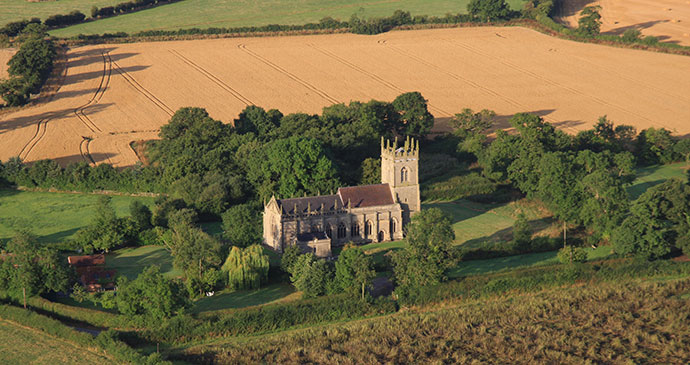
Built soon afterwards, between 1406 and 1408, to commemorate the thousands killed in the battle, the church was restored by Shrewsbury architect Samuel Pountney Smith in 1860–1862 and funded for the main part by the Corbet family. The hammerbeam roof, from the restoration, features the heraldry of knights who fought in the battle.
The bright light in the vestry belies its former function as the Corbet mortuary chapel, but don’t miss the floor tiles shaped like a coffin. The chancel houses a rare and mournful 15th-century sculpted oak pietà – the Virgin Mary cradling her dead son – thought to have been salvaged from a chapel at nearby Albright Hussey.
St Edmund’s Church, Southwold
Away from the seafront at the town of Southwold in Suffolk, the high street heads inland past cafés, galleries and old-fashioned shops to St Edmund’s Church, a towering 15th-century building constructed of imported Caen stone with flint dressing. Look up as you enter and you will see the forlorn-looking figure of a tied-up Edmund above the door.
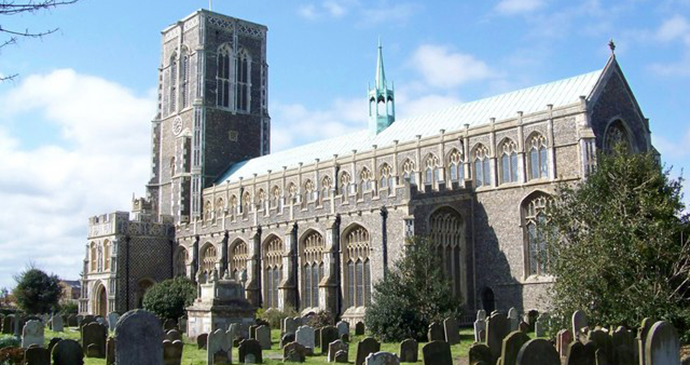
The church’s interior is quite beautiful, with an exquisite angel-bedecked roof and intricate steeple-like font cover that is 24 feet high. There’s also a figure called ‘Southwold Jack’, a soldier from the War of the Roses, who carries a sword and has an axe that rings a bell when the service is about to commence. The east window, which is by Sir Ninian Comper, has scenes from St Edmund’s martyrdom and is a 1954 replacement of an earlier window blown out by a German bomb landing just across the road in 1943.
Kirkby Stephen Parish Church, Kirkby Stephen
Some churches are extroverts, proud focal points on town high streets or village greens, but not so this one. Kirkby Stephen Parish Church is hidden away behind tall Georgian buildings lining the town’s main thoroughfare with an attractive, pink sandstone entrance porch the only clue to its presence. But once through the cloisters’ arch you’re transported back in time and into an oasis of peace and quiet.
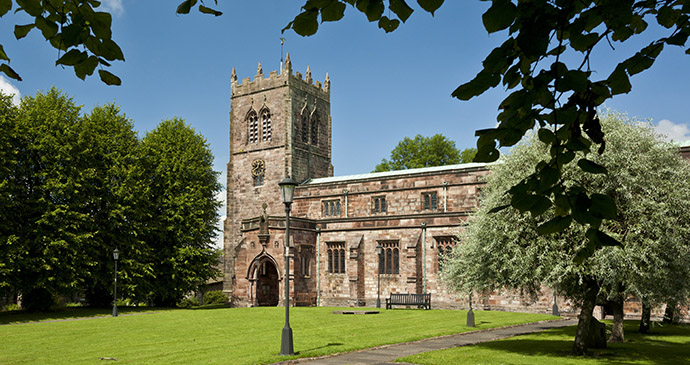
Inside are remnants of Saxon stone crosses, from when the church itself was thought to be a wooden structure, and a striking artefact from its Viking period. The Loki Stone is a decorated, rectangular stone block bearing a horned carved figure in chains thought to represent Loki, the Norse god of mischief (Tom Hiddleston to our younger readers).
Most of the present church is medieval, including two unusual separate chapels at the eastern end, both dedicated to local aristocratic families. A very old tradition has resulted in a clock chime anomaly from the church bell tower. After the 20.00 hour chimes an additional bell is rung to sound the night-time curfew, known locally as the Taggy Bell. If children weren’t home by this time they were threatened with the ‘Taggyman’.
Hexham Abbey, Northumberland
Founded in AD674 by Wilfrid, Bishop of York, the abbey was originally built as a monastery, but very quickly became a church. It was said by a follower of Wilfrid’s (Eddius Stephanus) to be of greater beauty than anything ‘this side of the Alps’.
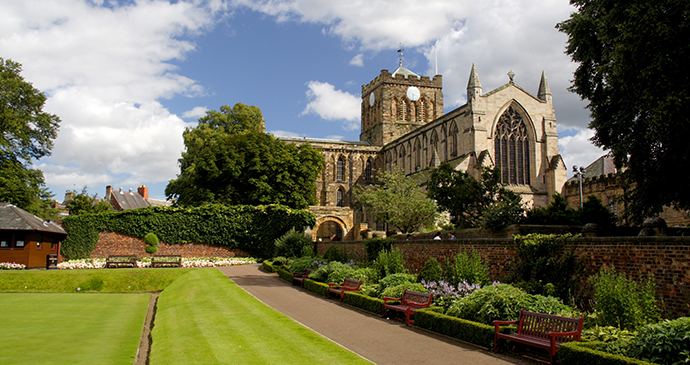
Today, the only surviving part of Wilfrid’s wondrous building is the crypt, reached by descending a stone staircase in the nave. The warren of tight passages and chambers was constructed using Roman masonry from nearby Corbridge, in which you can see carvings and lettering.
Wells Cathedral, Wells
Exerting a tremendous presence for miles around, Wells Cathedral is not only one of the finest ecclesiastical monuments in England but lays fair claim to being the first complete Gothic cathedral in the country. Begun in the late 12th century by Bishop Robert of Lewes, it was built on the site of an earlier church (of which there are a few extant remains) with subsequent additions further down the line. As a secular establishment, the cathedral survived more or less unscathed following the Reformation, though it did suffer fairly extensive damage during the later Civil War.
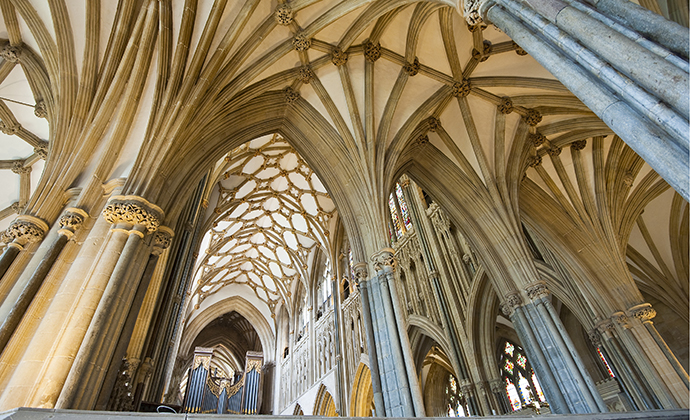
The cathedral’s single greatest triumph is the octagonal Chapterhouse, a glorious, light-filled room centred on a single column of Purbeck marble supporting an elaborately ribbed ceiling; the room was formerly used for church legal proceedings (hence the stone seats), though today it’s utilised for exhibitions and performances.











